#Central Lenin Stadium
Explore tagged Tumblr posts
Text
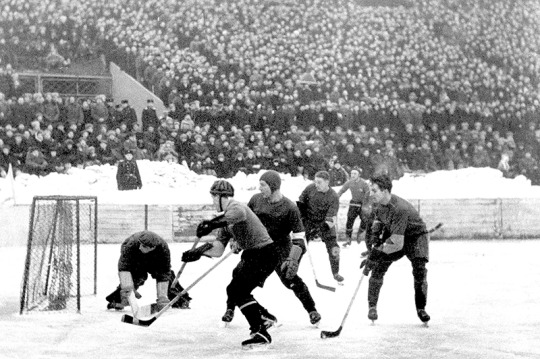
Some action around the goalmouth of CDSA Moscow (now CSKA), wearing the dark sweaters, during a 1952 game against Spartak. I'm not sure of very many player identifications in this one, but that's Grigory Mkrtychan in goal for CDSA, and it sure looks like Anatoly Tarasov guarding the slot behind the three skaters in the foreground.
Note the early protective equipment: the elbow pads worn outside the sweaters of all three CKSA skaters, the cycling helmet worn by the Spartak attacker in the foreground, and what seems to be water-polo headgear on the CDSA defenceman just behind him.
The site of the game is almost certainly the Central Lenin Stadium in Moscow (now the Luzhniki).
(Image Source)
#USSR#Soviet Hockey#CDSA Moscow#CSKA Moscow#Central Red Army#Spartak Moscow#Outdoor Hockey#Central Lenin Stadium#Grigory Mkrtychan#Anatoly Tarasov#Goalies#Defencemen#Forwards#Soviet Championship
4 notes
·
View notes
Text

A holiday ice show in the Sports Palace of the Lenin Central Stadium. Photo by M. Ozyorsky (Moscow, 1959).
91 notes
·
View notes
Text
Wilt Chamberlain Wiki, Bio, Age, Career, Education, Relationship, Death, Net Worth, Nationality And More

Wilt Chamberlain Wiki:- American basketball player Wilton Norman Chamberlain, who played centre, was born on August 21, 1936 and passed away on October 12, 1999. He is regarded as one of the greatest players in the history of the National Basketball Association (NBA), standing at 7 ft 1 in (2.16 m) tall. He played in the NBA for 14 years. The claim that Chamberlain is the all-time best player has been made by a number of athletes and newspapers. Blocks were not tallied during his career, but he retains multiple NBA regular season records in the areas of scoring, rebounding, and durability.
Wilt Chamberlain Wiki
Wilt Chamberlain was chosen for the 35th, 50th, and 75th anniversary teams of the NBA in 1978. Additionally, he was admitted to the Naismith Memorial Basketball Hall of Fame. In the short-lived International Volleyball Association, Chamberlain played volleyball after his professional basketball career ended (IVA). In recognition of his contributions, he was once league president and is now a member of the IVA Hall of Fame. He played the enemy in the 1984 Conan the Destroyer movie starring Arnold Schwarzenegger, who was known for his power.

Wilt Chamberlain
Parents And Education
Chamberlain was born on August 21, 1936, in Philadelphia, Pennsylvania, the ninth child of a family of nine. His parents were domestic worker and homemaker Olivia Ruth Johnson and welder, custodian, and handyman William Chamberlain. He was a weak child who missed an entire year of school due to pneumonia in his early years. Chamberlain was always quite tall; at age 10, he was already 6 feet 0 inches tall. Chamberlain initially had no interest in basketball because he perceived it as "a game for sissies."
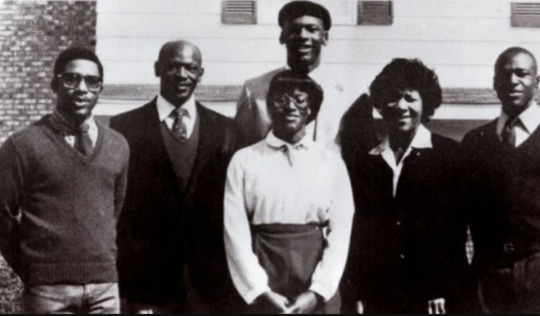
wilt chamberlain parents
Career
Before finishing his senior year, Chamberlain intended to turn pro after his disappointing junior year. Chamberlain decided to play for the Harlem Globetrotters in 1958 for a fee of $50,000. He became a member of the Globetrotters team that made history by playing in Moscow in 1959; the team enjoyed a sold-out tour of the Soviet Union. At the time, the NBA did not accept players until after their college graduating class had been completed, and Chamberlain was prohibited from joining the NBA for a year. They were welcomed by General Secretary Nikita Khrushchev prior to the start of a game at Moscow's Lenin Central Stadium.

wilt chamberlain career
Death
Chamberlain has a history of cardiovascular issues, and he briefly visited the hospital in 1992 as a result of irregular pulse. Those close to him claim that he ultimately started taking medicine for his cardiac issues. In 1999, his health drastically declined and he lost 50 pounds. The week before Chamberlain passed away, he underwent dental surgery. He was in excruciating pain and didn't seem able to recover. On October 12, 1999, Chamberlain, 63, passed away in his Bel Air home. According to Chamberlain's agent Sy Goldberg, congestive heart disease caused his death.

wilt chamberlain death
Relationship
In 1991, Chamberlain released the book A View From Above. He talked about his stint in the NBA and his thoughts on other legendary basketball players throughout time. Chamberlain made a claim about his love life in the book that is still hotly contested today. In A View From Above, Chamberlain asserted that he had slept with 20,000 various women throughout the course of his lifetime. That figure may be even more astounding given all the mind-numbing data Chamberlain compiled while playing in the league.

wilt chamberlain relationship
Net Worth
Even $10 million richer Wilt Chamberlain regarded Richman as a father figure in his life. The two were closely related to one another. The connection was so strong that Richman gave Chamberlain a 25% ownership part in the 76ers.
Nationality
American INSTAGRAM FAQ ABOUT WILT CHAMBERLAIN
Q.1 Who is Wilt Chamberlain?
Ans. Wilt Chamberlain is American basketball player.
Q.2 Is Wilt Chamberlain has kids?
Ans. Not available
Q.3 What is the net worth of Wilt Chamberlain?
Ans. $10million Read Also: Burt Bacharach Wiki Read the full article
#WiltChamberlainAge#WiltChamberlainBio#WiltChamberlainCareer#WiltChamberlainDeath#WiltChamberlainEducation#WiltChamberlainNationality#WiltChamberlainNetWorth#WiltChamberlainRelationship#WiltChamberlainWiki
0 notes
Text
okay so when bakunin first theorized the labor aristocracy it was a criticism of the idea that organized workers are the most radical, pointing towards the tendency of high-wage workers to unionize and then not include middle- and low-wage workers. lenin would go on to apply this theory to imperialism, arguing that workers in the imperial core may organize amongst themselves but since they still have short-term gains in the form of imperial superprofits, they will refuse to build a global proletariat in order to bring about true socialism. while this is one of his less popular theories, he would continue to stand by it later in life when he argued that the ussr was in a transitional state between capitalism and socialism since there wasnt an organized global proletariat with control over the world as there would be under true socialism and the ruling party of the ussr was solely the soviet proletariat.
in any case thats not what im talking about. im talking about bakunins idea of the labor aristocracy. one of the more popular examples for this concept is sports unions, in which high-wage millionaire athletes will unionize amongst themselves but refuse to fight for middle- and low-wage workers eg stadium workers.
meanwhile, the state of womens sports is a labor rights disaster. the average nwsl (the main pro womens soccer league in the us) player makes $31,000/year, in comparison to the average mls (main pro mens soccer league in the us) player who makes $398,000/year. workplace sexual harassment against athletes proliferates in the nwsl. there are initiatives to improve this. the pwhl, created in late 2023, has set itself the goal of being the first professional womens hockey to pay its athletes a livable wage, because yes, prior to the pwhl, the average nhl (main mens pro hockey league) salary was $3.5 million/year while the average phf (one of the main womens pro hockey leagues prior to the pwhl) salary was $34,000/year, meaning that most phf players could not play full time due to being forced to take second jobs. the pwhl's success towards this goal has been imperfect at best. coaching assistants still have to work second jobs and lower-wage athletes still arent able to make rent
but this isnt even close to a central issue to anyone discussing labor rights issues in entertainment. why not? because theres still a belief that the rights of women should not be a central issue to any serious labor organizer. this is particularly problematic because women are one of the groups most open to being radicalized. but since theres no coherent marxist feminist movement in the us, liberal choice feminism and bioessentialist "radical" feminism proliferates with little pushback from marxist groups
that reminds me though i was gonna make a point about traditional theor. hold on i just lost my entire train of thought let me finish my toast and coffee and ill get back to this heres my bullet notes though
traditional labor aristocracy theory -- not lenins anti-imperialist reinterpretation
low wage workers not being involved in or protected by sports unions the same way millionaire athletes are
labor rights in womens sports
how the lack of a marxist feminist movement has failed women athletes
3 notes
·
View notes
Photo










Luzhniki Stadium, In the past its field was mainly used (at various times) for football games played by PFC CSKA Moscow, Torpedo Moscow and Spartak Moscow, but none of these teams are based there any more. Today it is mainly used as one of the home grounds of the Russian national football team.
It also hosts European games for other football clubs, such as Rubin Kazan, owing to the home stadiums of the respective clubs not meeting UEFA standards.
The final of the 2018 FIFA World Cup will be played at the Luzhniki Stadium.
58 notes
·
View notes
Link
#soviet postcard#sport postcard#russian postcard#USSR vintage#collectible#eBay#Moscow#Moscow Central STADIUM named LENIN#Swimming pool#STADIUM#postcard 1957
0 notes
Text
Events 9.17
1111 – Highest Galician nobility led by Pedro Fróilaz de Traba and the bishop Diego Gelmírez crown Alfonso VII as "King of Galicia". 1176 – The Battle of Myriokephalon is the last attempt by the Byzantine Empire to recover central Anatolia from the Seljuk Turks. 1382 – Louis the Great's daughter, Mary, is crowned "king" of Hungary. 1462 – Thirteen Years' War: A Polish army under Piotr Dunin decisively defeats the Teutonic Order at the Battle of Świecino. 1577 – The Treaty of Bergerac is signed between King Henry III of France and the Huguenots. 1620 – Polish–Ottoman War: The Ottoman Empire defeats the Polish–Lithuanian Commonwealth during the Battle of Cecora. 1631 – Sweden wins a major victory at the Battle of Breitenfeld against the Holy Roman Empire during the Thirty Years' War. 1658 – The Battle of Vilanova is fought between Portugal and Spain during the Portuguese Restoration War. 1683 – Antonie van Leeuwenhoek writes a letter to the Royal Society describing "animalcules", later known as protozoa. 1775 – American Revolutionary War: The Invasion of Canada begins with the Siege of Fort St. Jean. 1776 – The Presidio of San Francisco is founded in New Spain. 1778 – The Treaty of Fort Pitt is signed. It is the first formal treaty between the United States and a Native American tribe. 1787 – The United States Constitution is signed in Philadelphia. 1793 – War of the Pyrenees: France defeats a Spanish force at the Battle of Peyrestortes. 1794 – Flanders Campaign: France completes its conquest of the Austrian Netherlands at the Battle of Sprimont. 1809 – Peace between Sweden and Russia in the Finnish War; the territory that will become Finland is ceded to Russia by the Treaty of Fredrikshamn. 1849 – American abolitionist Harriet Tubman escapes from slavery. 1859 – Joshua A. Norton declares himself "Norton I, Emperor of the United States." 1861 – Argentine Civil Wars: The State of Buenos Aires defeats the Argentine Confederation at the Battle of Pavón. 1862 – American Civil War: George B. McClellan halts the northward drive of Robert E. Lee's Confederate Army in the single-day Battle of Antietam, the bloodiest day in American military history. 1862 – American Civil War: The Allegheny Arsenal explosion results in the single largest civilian disaster during the war. 1894 – Battle of the Yalu River, the largest naval engagement of the First Sino-Japanese War. 1900 – Philippine–American War: Filipinos under Juan Cailles defeat Americans under Colonel Benjamin F. Cheatham Jr. at Mabitac. 1901 – Second Boer War: A Boer column defeats a British force at the Battle of Blood River Poort. 1901 – Second Boer War: Boers capture a squadron of the 17th Lancers at the Battle of Elands River. 1908 – The Wright Flyer flown by Orville Wright, with Lieutenant Thomas Selfridge as passenger, crashes, killing Selfridge, who becomes the first airplane fatality. 1914 – Andrew Fisher becomes Prime Minister of Australia for the third time. 1914 – World War I: The Race to the Sea begins. 1916 – World War I: Manfred von Richthofen ("The Red Baron"), a flying ace of the German Luftstreitkräfte, wins his first aerial combat near Cambrai, France. 1920 – The National Football League is organized as the American Professional Football Association in Canton, Ohio. 1924 – The Border Protection Corps is established in the Second Polish Republic for the defence of the eastern border against armed Soviet raids and local bandits. 1928 – The Okeechobee hurricane strikes southeastern Florida, killing more than 2,500 people. 1930 – The Kurdish Ararat rebellion is suppressed by the Turks. 1932 – A speech by Laureano Gómez leads to the escalation of the Leticia Incident. 1935 – The Niagara Gorge Railroad ceases operations after a rockslide. 1939 – World War II: The Soviet invasion of Poland begins. 1939 – World War II: German submarine U-29 sinks the British aircraft carrier HMS Courageous. 1940 – World War II: Due to setbacks in the Battle of Britain and approaching autumn weather, Hitler postpones Operation Sea Lion. 1941 – World War II: A decree of the Soviet State Committee of Defense restores compulsory military training. 1941 – World War II: Soviet forces enter Tehran during the Anglo-Soviet invasion of Iran. 1944 – World War II: Allied airborne troops parachute into the Netherlands as the "Market" half of Operation Market Garden. 1944 – World War II: Soviet troops launch the Tallinn Offensive against Germany and pro-independence Estonian units. 1944 – World War II: German forces are attacked by the Allies in the Battle of San Marino. 1948 – The Lehi (also known as the Stern gang) assassinates Count Folke Bernadotte, who was appointed by the United Nations to mediate between the Arab nations and Israel. 1948 – The Nizam of Hyderabad surrenders his sovereignty over the Hyderabad State and joins the Indian Union. 1949 – The Canadian steamship SS Noronic burns in Toronto Harbour with the loss of over 118 lives. 1961 – The world's first retractable roof stadium, the Civic Arena, opens in Pittsburgh, Pennsylvania. 1961 – Northwest Orient Airlines Flight 706 crashes during takeoff from O'Hare International Airport in Chicago, Illinois, killing all 37 people on board. 1965 – The Battle of Chawinda is fought between Pakistan and India. 1974 – Bangladesh, Grenada and Guinea-Bissau join the United Nations. 1976 – The Space Shuttle Enterprise is unveiled by NASA. 1978 – The Camp David Accords are signed by Israel and Egypt. 1980 – After weeks of strikes at the Lenin Shipyard in Gdańsk, Poland, the nationwide independent trade union Solidarity is established. 1980 – Former Nicaraguan President Anastasio Somoza Debayle is killed in Asunción, Paraguay. 1983 – Vanessa Williams becomes the first black Miss America. 1991 – Estonia, North Korea, South Korea, Latvia, Lithuania, the Marshall Islands and Micronesia join the United Nations. 1991 – The first version of the Linux kernel (0.01) is released to the Internet. 1992 – An Iranian Kurdish leader and his two joiners are assassinated by political militants in Berlin. 2001 – The New York Stock Exchange reopens for trading after the September 11 attacks, the longest closure since the Great Depression. 2006 – Fourpeaked Mountain in Alaska erupts, marking the first eruption for the volcano in at least 10,000 years. 2006 – An audio tape of a private speech by Hungarian Prime Minister Ferenc Gyurcsány is leaked to the public, in which he confessed that his Hungarian Socialist Party had lied to win the 2006 election, sparking widespread protests across the country. 2011 – Occupy Wall Street movement begins in Zuccotti Park, New York City. 2013 – Grand Theft Auto V earns more than half a billion dollars on its first day of release. 2016 – Two bombs explode in Seaside Park, New Jersey, and Manhattan. Thirty-one people are injured in the Manhattan bombing. 2018 – A Russian reconnaissance aircraft carrying 15 people on board is brought down by a Syrian surface-to-air missile over the Mediterranean Sea.
2 notes
·
View notes
Text
Almaty, formerly known as Alma-Ata, is the largest city in Kazakhstan, with a population of around 2,040,000 people, about 11% of the country’s total population and more than 2,7 million in its built-up area that encompasses Talgar, Boraldai, Otegen Batyr and many other suburbs. It served as capital of the Kazakh state in its various forms from 1929 to 1997, under the influence of the then Soviet Union and its appointees. In 1997, the government relocated the capital to Astana (today known as “Nur-Sultan” as of 23 March 2019) in the north of the country and about 12 hours away by train.
youtube
Almaty continues as the major commercial and cultural centre of Kazakhstan, as well as its most populous and most cosmopolitan city. The city is located in the mountainous area of southern Kazakhstan in the foothills of the Trans-Ili Alatau at an elevation of 700–900 m (2,300–3,000 feet), where the Large and Small Almatinka rivers run into the plain.
The city has been part of the UNESCO Creative Cities Network in the area of music since November 2017. The name Almaty has its roots in the medieval settlement Almatu, that existed near the present-day city. A disputed theory holds that the name is derived from the Kazakh word for ‘apple’ (алма), and is often translated as “full of apples”. Originally it was Almatau which means Apple Mountain. The Russian version of the name was Alma-Ata (Kaz. Father of Apples). Since gaining its independence from the Soviet Union, the use of the Kazakh Almaty is accepted.
Double Tree Hilton Almaty Recommended hotel accommodation DoubleTree by Hilton Almaty is a bright and modern hotel in the foothills of the Trans-Ili Alatau mountains, just a 5-minute walk to Baikonur Metro Station, Almaty Central Stadium and Kazakh State Circus. Discover local artists’ works at the bustling Arbat Market or see shows at the Abay Kazakh State Academic Theatre of Opera and Ballet, all 6 minutes away. We’re also 10 minutes from the Botanical Garden, Green Bazaar and Central State Museum of Kazakhstan.
Multimediacenter of Traditional Music Traditional music school of Zhetysu – One of the traditional Kazakh musical school of Kui and zhyr came from the Zhetysu region. The authors such as Kebekbay, Nogaybay, Kenen, Kapez are representatives of this school. Founders of “School of Zhetysu zhyrau art” Kaban, Suyinbay, Zhambyl and Umbetali had a vital influence on the formation of poetry and zhyr. Uniqueness of “School of Zhentysu kui art” is it’s antiquity. All kui compositions are based on the events from the Kazakh history. The composers such as Bayserke, Kozheke, Mergenbay, Erdeneuly, Tilendi Atabaiuly, had made big contribution to the school of kui.
National craft center Qazag Oner Qazaq-Oner is a center of artisans with the purpose of development of external and inner tourism. This is a kazakhstani first unique project that develop and promote the national-applied arts of our nation. Qazaq-Oner artisan center is including training, production, shopping, cultural and historical and entertainments. Our guests can spend their time useful and interesting.
State Museum of Arts of Republic of Kazakhstan In January 1984 the museum was named after People’s Artist of the Kazakh SSR A. Kasteyev (1904-1973). Abilkhan Kasteev was a Kazakhstani painter. He was highly decorated, winning the National Artist of Kazakh SSR, and The Laureate of the Chokan Valikhanov State Premium of the Kazakh SSR. He was awarded the Order of October Revolution, and two Orders of Labour Red Flag. Kasteev was born in a small village in Taldykorgan Region and studied at the Nadezhda Krupskaya art studio in Almaty. He painted more than a thousand paintings in oil and water-colours. Some of his works are on display in the State Tretyakov Gallery, in the State Museum of East Nations Art, in the Central Museum of USSR Revolution by Lenin Order in Moscow, and in the State Museum of Fine Arts of Kazakhstan. Currently, the A. Kasteyev State Museum of Arts of the Republic of Kazakhstan is the largest art museum and the country’s leading research, cultural and educational center in the field of fine arts. Rich, diverse, precious collection gives a vivid picture of the artistic culture of Kazakhstan, Europe and Asia, the masters of past ages and the present time. Number of exhibits of the main fund of the museum is more than 25 000 units.
Cablecar to Kok-tobe Hill The hill the TV mast stands on, is the highest point of the city in Almaty at 1100 metres and the mast itself is 350 meters tall, and built in stainless steel (No heavy concrete). The viewpoint from Kok-tobe is well worth a visit with the panoramic views of the city in all directions. A cable car ride is a really very good way to the top of Kok-tobe Hill, and see the view of surrounding mountains, the start of which is located close to the Hotel Kazakhstan. The cable car goes over some of the oldest parts of Almaty. On the top you find a nice souvenir shop and a wonderful statue of the Beatles.
Navat restaurant lunch. NAVAT – a vivid example of the legendary Eastern cultures meeting and receiving respected guests. NAVAT is an oasis for lovers of oriental cuisine among the noise and bustle of the city.
youtube
Alasha restaurant dinner with Kazakh Beshbarmak basically means “five fingers” in Kazakhstan. It is probably the most popular dish in the land. The name five fingers is what is required to enjoy it, all five of them. Typically this dish is made with either horse meat or mutton. Beef is sometimes used but the others are much more common. In fact horse meat is so common in Kazakhstan that Olympians had to beg the Olympic committee to allow them to bring it the games so that they could maintain their normal diet. Needless to say, you can certainly enjoy this dish made with beef or lamb and be authentic. This dish is almost always served on a large platter to be enjoyed by guests on a Darsakstan (either a low table or clear cloth over a rug, on the floor) . Be sure to use all five fingers, it is a real treat and fun to do. This is also almost always served with a bowl of the broth on the side called shorpa. See https://www.internationalcuisine.com/kazakh-shorpa/ for the the proper way to serve it. Also if you don’t have the time to make the noodles from scratch, you can use lasagna noodles as a fine substitute. A delicious main dish from Kazakhstan.
youtube
Almaty – the largest city in Kazakhstan Almaty, formerly known as Alma-Ata, is the largest city in Kazakhstan, with a population of around 2,040,000 people, about 11% of the country's total population and more than 2,7 million in its built-up area that encompasses Talgar, Boraldai, Otegen Batyr and many other suburbs.
2 notes
·
View notes
Text
Chernobyl!!
23 May
Those of us who signed up for the full day trip to inside Chernobyl’s exclusion zone were up early in our long pants,sleeves,with enclosed shoes with our passports ready for the security checks to go into the zone. We signed our lives away on a safety waiver, and check in sheets that go to the highly controlled checkpoints located at the different zone crossings. Visits to the area are highly controlled with only a few tour companies given permission to enter, they are required to wear a tracker at all times so they are monitored to ensure they are not going into areas where they are not permitted. We were all required to wear dosimeters so that our radiation exposure could be checked at the end of the day. Our guide, Alexi, gave us some amazing insights he has learned from years of research, insights into not only the events that lead up to what occurred in the early hours of 26th April 1986, but also the time line of sorts of what was done afterwards. A lot of the ‘truths’ surrounding the reactor explosion were lost when witnesses died, or were buried by the propaganda and coverups of the Soviets at the time. Don’t forget it took for America to call them out with the incontrovertible satellite photos of the blast for the Soviets to admit anything had happened, let alone take steps to contain the ongoing radiation leakage and further risks of explosions. When it comes to information surrounding Chernobyl it’s difficult to find a complete story, let alone be able to fact check anything. Alexi gave us the name of a you tube documentary that he advised shows the true side of what happened in reactor 4 on 26 April 1986. The " Battle of Chernobyl" if you want to look it up!

First up was a stop in Zalesye, an abandoned village within the exclusion zone. It was surreal, to step off the bus, knowing that we were walking down a main street, but seeing nothing but vegetation. Then through avenues in the trees we came across the remains of the houses, we then entered into the old town hall building with its rotting floors, and decaying walls. There were still old signs on the walls. I managed to get myself what I like to call a ‘shin - obyl’ bruise on my way in, as only I can - stacked it climbing up onto the entry. Luckily one of my bus mates helped me up as we were told not to touch walls, or ground...or anything really ... so that would be why we had to wear long pants (for when idiots like me fall over!)
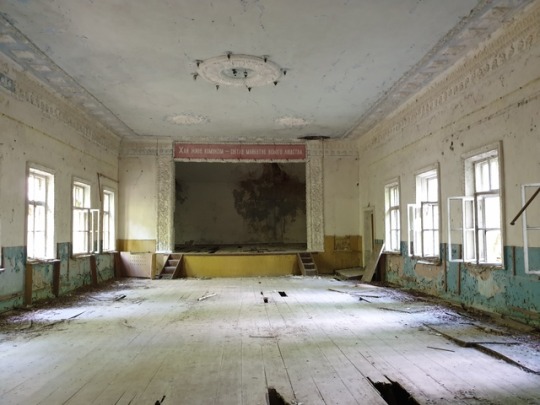
The next stop was the reason the power stations were built, the Duga radar. Holy huge metal antenna array... when you know that the huge, costly, power hungry radar actually wasn’t that good at its job makes the events of the reactor explosion seem even more of an avoidable incident. Incredibly, you would have no idea that it was there until you walk into the forest of vegetation, then it’s an ‘oh my’ moment at it’s sheer size and the wonder of the precision of the components. It is slowly rusting, and someone died climbing it a few years ago, so we were not allowed to climb it.
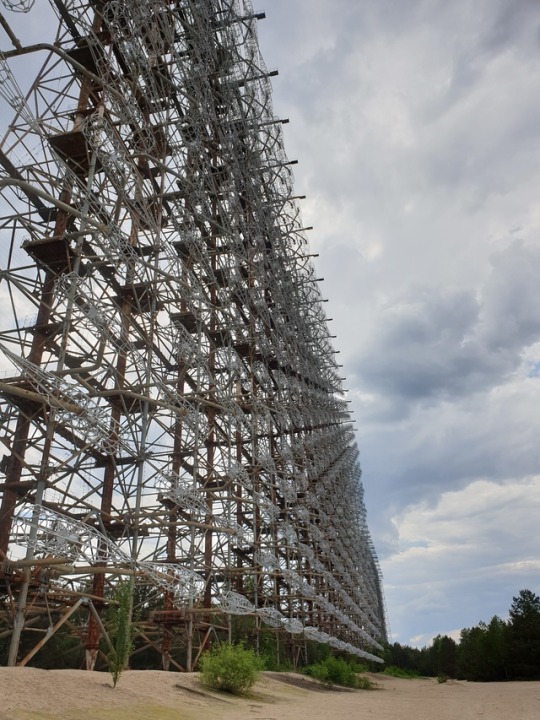
We then headed to Chernobyl and the Reactor canteen for lunch. Yes, complete canteen lunch on a tray... Soup, mains, desert, replete with unsmiling Ukrainian canteen ladies serving it to us. With the extra bread we’d grabbed at lunch we then fed fish from the railway bridge near the reactors. Then it was up close to reactor 4 and the monument for it. I couldn’t believe we were able to get to within about 200m of it. Although there are strict rules on photos in this area - can only shoot in one direction, and there are guards and cameras everywhere.
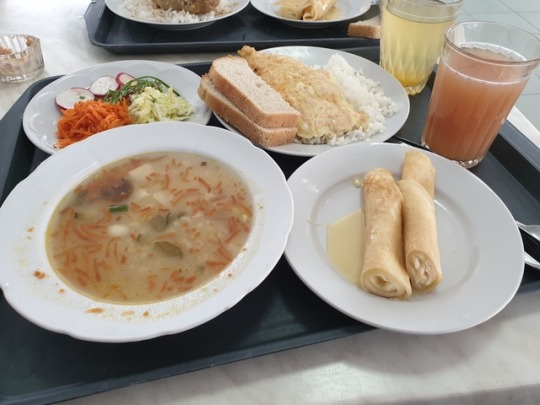
Chernobyl town was the administrative centre for the district and until its evacuation on the 30th April 1986, housed about 14000 people It was not as close to the site as our next stop.
Alexi gave us an interesting parallel: apparently ‘Chernobyl’ means wormwood in Russian. In Chernobyl town, 164 died as part of the first responders to the explosion, and there is a memorial that has been erected in the central square depicting an Angel blowing a trumpet. The 8th book of revelations talks of a cataclysmic event : “And the third angel sounded, and there fell a great star from heaven, burning as it were a lamp, and it fell upon the third part of the rivers, and upon the fountains of waters; And the name of the star is called Wormwood: and the third part of the waters became wormwood; and many men died of the waters, because they were made bitter.” Revelation 8:10-11. Draw from that whatever conclusions you will, interesting nonetheless...
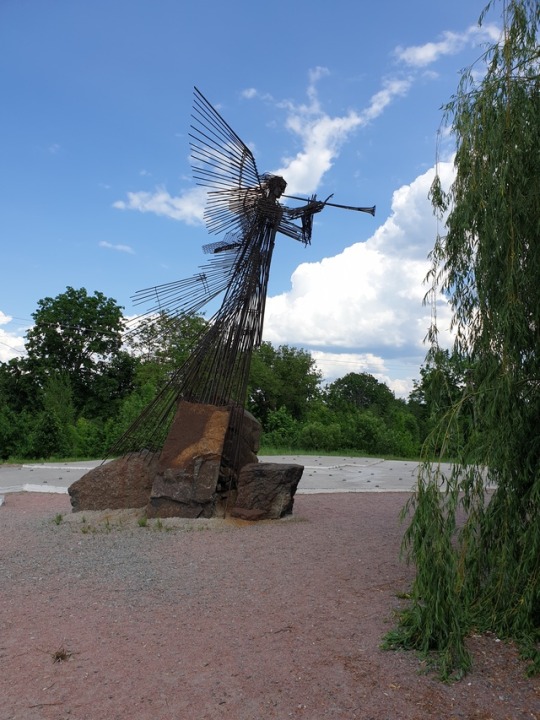
Pripyat was designed to be new age city of sorts, with its amusement park, cafes, art installations, hotels, apartments it was coming into itself with 50000 residents, housing workers at the power plant. It was finally evacuated in the afternoon of the 27th April 1986, with residents being told they would be gone for a couple of days and to just grab a few things and leave their pets. They were never allowed to return. We climbed through the maternity hospital, where the abortions were performed, with some of its records and equipment still intact. We were warned not to touch anything that still remained as it would still be highly radioactive. Trekking through the vegetation we came across what once was a beautiful cafe on the banks of the river that was due to open on the day the city was evacuated. The stained glass art that had adorned its window depicting the four seasons, some still intact, the rest of it lying shattered on the ground. From there we headed to the sports stadium, through what we later realised was the soccer field (no sign that it was there!) To me it was incredible to see sparks of beauty still there, the glass work in the cafe, the tile art adorning the external sides of two of the buildings we saw. We ventured into the pool area of the sports complex, it’s dive platform still intact, tiles, ladders, everything still there, just decaying, old, or vandalised by some who have snuck into the area over the years. It was then time for the iconic amusement park. Again something that was only just opening when the incident occurred. It stands as a rusting memory of time gone by, bumper cars, Ferris wheel, all the fun of the fair, with that eerie overtone of nothingness or is it hopelessness, I’m not sure.

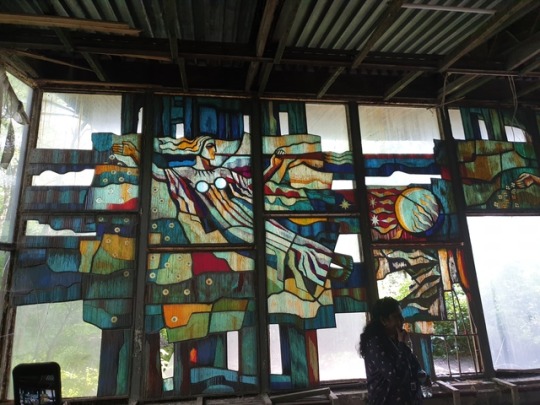
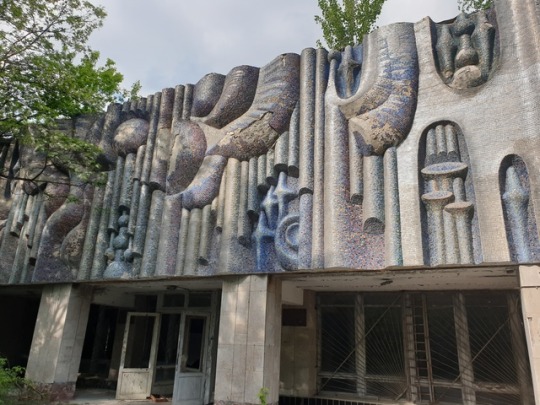

We then took off to see the last Lenin statue in Ukraine, all others have been removed. It is still located outside of the Communist party building where the ‘fake’ trial took place of a power plant director and 2 engineers, where they were found guilty of negligence and the the blame placed on them for the incident. Nothing of course said about the safety measures that were supposed to have been installed in the reactor, or the fact that they failed, or they fact that the staff were following orders as required under Soviet rule. The Chernobyl town is home to what are known as the ‘self settlers’. Previous residents who have returned of their own volition to continue living in their property.
Our last stop was in the Red forest area, northern part of the exclusion zone. It apparently received the worst of the radiation. We entered the kindergarten where to my dismay we learned that kids continued to be sent to for at least a week after the reactor explosion. Testing after the incident proved that everything including the toys they had played with were riddled with extremely high levels of radioactivity. It was poignant and incredibly sad to see the remains of the toys, the cribs/beds knowing that these children had been exposed to such toxic levels of radiation due to the inaction of the Soviet authorities.
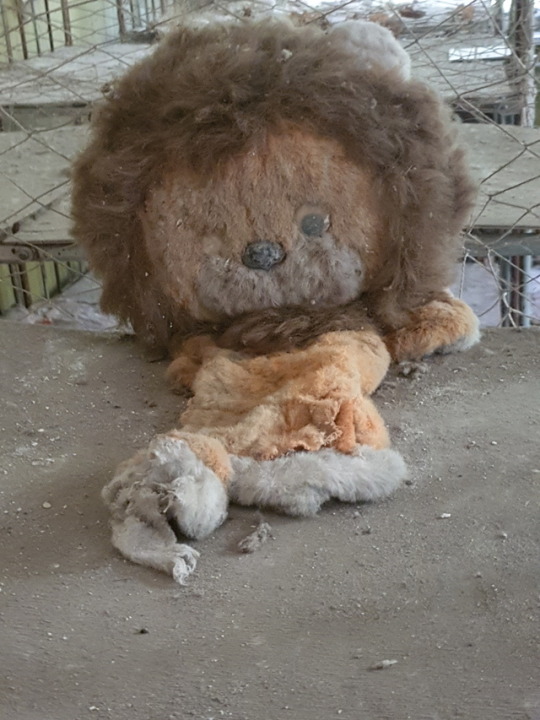
On our way out of the zone we stopped briefly at ‘The men who saved the world’. An un-offical memorial to the first attendees, doctors, firefighters etc, who all died in hospital number six in Russia and were then buried in lead coffins somewhere in Russia. Their families were not allowed to even see them or be at the burial.
On our way out of two checkpoints we had to submit to a full body radiation scan at each in order to check for any contamination. Luckily none of us had to be decontaminated (ie hosed down!). We were then given strict instruction to shower thoroughly and ensure our clothes were either washed or kept in an area safely before we washed them... On a side note the radiation we experienced for the day was somewhere around a 5 or 6 hour transatlantic flight so I pretty much got more radiation flying over to Europe than I did wandering around all day - good to know though!
It was an amazing day. A long one, we're all tired. But wow. How lucky am I that I got to do this. Mother nature has given the human race and it's nuclear power a big fuck you. And I love it! It's surreal to walk down what was once a street realising that on both sides of you hidden by nature's growth stands the time capsule of the crumbling remnants of the buildings of whole towns. Nature has rebounded here in spades, the birds chirping constantly, the land brimming with growth, the fish teeming - and no, none of them have 2 heads or mutations anymore. Apparently nature very quickly removes such mutations when they serve no purpose. The amusement park, a ghost town of rusting steel and decaying wood. The beautiful art works of tile and glass slowly deteriorating. It's eerie, and incredibly fascinating. My emotions are everywhere. Our guide is so passionate about what happened here and what the Soviets did to cover up their mistakes and the impact this had on the people who are still affected to this day, with no accurate records of how many have died from exposure in the years since the explosion. I was astounded how close we were able to get to reactor four. Incredibly saddened at how little care was taken of the people here. This Chernobyl adventure will stay with me forever, and has left an indelible mark on my psyche. If you don’t know much about this story, read more, find as much of the truth as you can, and most important of all - never forget.
2 notes
·
View notes
Photo

Up Yours Moscow! On 30th July 1980 Polish athlete Władysław Kozakiewicz won the Olympic pole vault gold medal in front of an abusive crowd in Moscow's Central Lenin Stadium (now the Luzhniki Stadium). The atmosphere within the stadium was very hostile throughout the competition, with the Russian crowd booing, hissing and whistling the non-Soviet athletes. This irritated Kozakiewicz, who after jumping 5.70 metres (higher than any other competitor that day) responded with an "up yours!" gesture to the jeering spectators. He then repeated the gesture after clearing 5.75 metres, which ensured his victory over the local favourite, Konstantin Volkov. He finally confirmed his dominance over the competition by breaking the world record with a jump of 5.78 metres. Photos of the incident circled the globe, with the notable exception of the Soviet Union and its satellites. Nevertheless, many people in the Soviet Bloc saw it, as the event was broadcast live on TV in most countries behind the Iron Curtain. After the 1980 Olympics ended, the Soviet ambassador to Poland demanded that Kozakiewicz be stripped of his medal to punish him for "insulting the Soviet people". The official response of the Polish government was that the gesture had been an involuntary muscle spasm caused by his exertion....
#wladyslaw kozakiewicz#władysław kozakiewicz#poland#polska#history#moscow#olympics#pole vault#ussr#soviet union#russia#up yours#fuck off#spierdalaj#1980s#1980
51 notes
·
View notes
Text
That time Zakk Wylde, Mick Mars, Snake Sabo and more joined forces to cover Led Zeppelin's Rock and Roll – in the Soviet Union
New Post has been published on https://petnews2day.com/pet-news/small-pet-news/that-time-zakk-wylde-mick-mars-snake-sabo-and-more-joined-forces-to-cover-led-zeppelins-rock-and-roll-in-the-soviet-union/
That time Zakk Wylde, Mick Mars, Snake Sabo and more joined forces to cover Led Zeppelin's Rock and Roll – in the Soviet Union
For a number of reasons, the 1989 Moscow Music Peace Festival was unlike any other rock festival that had come before it – or, really, any that has been held since.
Envisioned as (opens in new tab) a “Russian Woodstock” that would, in theory, raise global awareness (opens in new tab) of drug and alcohol abuse, the festival gathered the biggest (not to mention craziest) acts in hard rock – Cinderella, Scorpions, Skid Row, Mötley Crüe, Ozzy Osbourne and Bon Jovi – behind the Iron Curtain, at a time when the Soviet Union had only just begun to open itself up officially to American and Western European popular music.
The festival inspired one of the billed acts to write an inspirational power ballad that would become one of the biggest hit singles in the history of popular music, and the drummer of another one of the bands to physically fight their manager, but more on that later…
Political and tabloid intrigue aside, the festival – held at Central Lenin Stadium (now known as Luzhniki Stadium) – had some truly killer performances, among them a set-closing jam session featuring the members of Skid Row and Mötley Crüe jamming on Led Zeppelin’s Rock and Roll with Zakk Wylde and Jason Bonham on drums.
You can see footage of the jam – which features Skid Row electric guitar player Snake Sabo, and Mötley guitarist Mick Mars in addition to Wylde – below.
Mötley Crüe singer Vince Neil and Skid Row frontman Sebastian Bach, trading off lead vocals, are each in prime form, but the guitarists bring plenty of energy, too. Rather than one-upping each other with head-cutting leads, Wylde, Sabo and Mars focus on the Zeppelin classic’s crushing rhythm parts, aided by a wall of what must’ve been indescribably loud Marshalls between them.
Despite the fun all participants were evidently having, the festival, perhaps inevitably, didn’t close out without some fireworks – both onstage and backstage.
Given that there were numerous stadium-headlining acts on the bill, there was some degree of conflict about who would “headline” the show. According to Rolling Stone‘s oral history of the festival (opens in new tab), the day the festival began, Ozzy Osbourne threatened to drop out if he did not receive higher billing, leading Doc McGhee – who at the time managed all the festival’s biggest acts sans Osbourne – to make the Prince of Darkness second on the bill, below Bon Jovi.
Mötley Crüe, already miffed about being second on the bill, were dropped to third. Furthermore, they were told in no uncertain terms by McGhee that pyrotechnics – a major feature of their typical stage show – were strictly off-limits, for all acts.
Imagine their – and the crowd’s – surprise, then, when there was a massive pyrotechnic explosion during a climactic moment in Bon Jovi’s set.
(from left) Richie Sambora, Jon Bon Jovi and Alec John Such perform with Bon Jovi at the 1989 Moscow Music Peace Festival at Luzhniki Stadium in Moscow, USSR (Image credit: Koh Hasebe/Shinko Music/Getty Images)
“I heard Tommy [Lee, Mötley’s drummer], coming down a ramp, [yelling] fuck you Doc McGhee, fuck you!” Sabo – who was backstage at the time – told Patrick Radden Keefe on his Wind of Change podcast.
“I immediately ran back, backstage, and found my manager, and I remember shoving him,” Lee told Rolling Stone (opens in new tab). “Like a big chest push, just ‘boom.’ And I pushed him on the ground, like ‘Fuck you, you fuckin’ lied to us. Tomorrow morning, you’ll be working for the fucking Chipmunks.'”
Avoiding – as they typically did – the backstage blow-ups that consumed many of their contemporaries, Scorpions, for their part, came away inspired by the festival. The energy and excitement they felt from the Russian audience would go on to inspire Wind of Change, a power ballad that celebrated the political changes coming to Eastern Europe. It would go on to not only become their biggest hit, but one of the best-selling singles (opens in new tab) of all time, in any genre.
“We went on a boat on the Moskva [River] down to Gorky Park, where they had a barbecue,” Scorpions frontman Klaus Meine told Rolling Stone (opens in new tab) in 2017. “I think it was the night before the first show [of the festival]. Stas Namin was running a so-called Hard Rock Café. There were some banners in the trees in this place they picked in the park, and they put speakers in there with music from all the bands.
“The entire world, musicians from America, England, Russia, Germany, all joining together in this boat with Red Army soldiers, MTV, media people – and everybody [is speaking] the same language: music.”
1 note
·
View note
Photo

A snowy night for hockey at the Central Lenin Stadium in Moscow, circa the mid-1950′s. (Image Source)
8 notes
·
View notes
Photo

It’s impossible to find any historical pictures of badminton, so here’s one of tennis.
Tennis instructor L. Agayan is training a group of young players at the gym of the Sports Palace of the Lenin Central Stadium. Photo by L. Dorensky (Moscow, 1958)
#sports#1950s#children#soviet union#soviet#ussr#russia#history#photography#vintage#retro#black and white
160 notes
·
View notes
Text
The Worst Tragedies in Sporting History
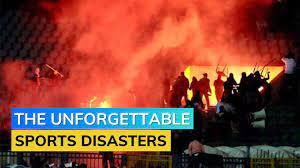
The incident in Indonesia shook the world, but it was not the first time lives were lost at a sporting event or in the sporting arena. Editorji looks back at some of the worst tragedies in sporting history till date:
The Munich Olympics 1972 Massacre The 1972 Munich Olympics held in Germany saw 11 of the Israeli Olympic team athletes held hostage and killed by a Palestinian group Black September
Bradford City Stadium Fire The worst fire disaster in the history of English football occurred on May 11, 1985 at the Valley Parade Stadium during a match against Lincoln City where a fire engulfed large sections of the stand killing 56 and injuring 256 people.
Puerta 12 Tragedy After a match between the Buenos Aires rivals Boca Juniors and River Plate, a stampede at gate 12, or puerta 12, killed 71 fans and left 150 injured.
Port Said Stadium Riot The Port Said Stadium Riot happened on February 1, 2012 at Port Said Stadium in Egypt where fans of Al-Masry started to attack the fans of Al-Ahly with knives, stones, bottles and other objects, causing a total of 79 deaths.
Estadio Mateo Flores Disaster The poor design of the stadium and the incessant number of fans who attempted to enter the venue for the 1998 FIFA World Cup qualification match between Guatemala and Costa Rica at the Estadio Mateo Flores on October 16, 1996 caused a human avalanche that killed 83 and injured 140 people.
Hillsborough Disaster Overcrowding in the stadium caused fans to climb over side fences of the Hillsborough Stadium on April 15, 1989 just to be able to witness the FA Cup semi-final match between Liverpool and Nottingham Forest. The structure couldn’t hold and 96 people died in the disaster.
Kathmandu Stadium Disaster Around 93 people were killed and 100 more were injured during the Kathmandu Stadium Disaster when fans attempted to run away from a hailstorm inside the national Dasarath Rangasala Stadium.
Indonesia Disaster In the most recent disaster till date, at least 174 people were killed and more than 200 sustained injuries after a stampede occurred at Kanjuruhan stadium following a riot that broke out in Indonesia's East Java Province.
Estadio Nacional Disaster On May 24, 1964 during a playoff game between Peru and Argentina at the National Stadium, major chaos followed the annulment of a goal by Peru when Argentina was already winning one-zero. This angered the fans and the police started to fire tear gas which eventually resulted in the death of around 318 people.
Luzhniki Disaster During the UEFA Cup second round match between FC Spartak Moscow and HFC Haarlem on October 20, 1982 at the Grand Sports Arena of the Central Lenin Stadium in Russia, the stampede which reportedly started because of a woman's lost shoe killed around 340 FC Spartak Moscow fans.
Read More:- The Worst Tragedies in Sporting History
1 note
·
View note
Photo

Latten Magism Shops
Zrntrale Aufobusholfettelle’
Tele die I< gne d’autobus Central but Station tjmkle derdume – Zentralstrand Cabinet de I’olle central# de la plogejl Clook’ooim at central beach out either on the sea or on the park. Five lifts, restaurant, tavema — “Melnik 4 — cake shop, four bars with seats, night club, and several conference rooms.
The mineral water has a temperature of 42°C at source.lt is slightly mineralized and is available in tubs at the hotel’s outdoor swimming pool. The balneotherapeutic clinic is equipped with modern electrical and medical apparatus. Treatments: curative tub dipping, massage, inhalation with sea water electrolux, sauna, scolarium, mud treatment and remedial exercises. The water is recommended for inflammatory and degenerative diseases of the locomotory system, chronic neuralgia, radicolitis, plexit, hypertension, atherosclerosis and mental fatigue. A slimming programme is also available.
The Joliot-Curie International House of Scientists, with 250 beds, is not far from the Varna Hotel. It has three conference rooms with facilities for simultaneous translation into four languages turkey sightseeing. ‘Mineral water treatment can be taken here under medical supervision.
Ralkantourist Bureau is at the Roubin Hotel, tel. 6-10-20. Varna (pop. 291, 224), Bulgaria’s third largest city is situated on the Black Sea coast at the head of Varna Bay between the Frangensko tableland to the north and the slopes of the Avren tableland to the south. It has a moderate continental climate with a mild humid winter and a warm dry summer. The mean annual temperature is 12°C.
The site of present-day Varna was inhabited in the Stone Age, traces of settlements have been found in the village of Beloslav and in the Pobiti Kamum (Stone Forest) area.
According to ancient chroniclers
According to ancient chroniclers, Varna was founded in the 4th century B.C. by Greek colonists and was then known as Odessos. In the 3rd-2nd century B,C. it was a flourishing town minting its own coins which bore the image of the Thracian god Darsala. In 72 B.C. it was conquered by the Romans but retained is autonomy until the establishment of the Roman province of Lower Moesia in the early years of the Christian era. After the division of the Roman Empire, the town came within the boundaries of the Eastern Roman Empire (Byzantium). It was surrounded by anew fortress wall and within that wall were temples, theatres, baths and stadiums. Later on, during the Christian era many churches were built, traces of which can still be seen (the basilica in Tsar Kroum St. and the Djanavar Tepe and Tourna Tepe churches). At the end of the 6th century the Slavs settled here, giving it the name of Vania, and in 681 it was captured by the proto-Bulgarians led by Khan Asparouh. It became a Bulgarian town in 1201 during the reign of Tsar Kaloyan.
In 1389 Vama fell under Ottoman rule. The town gained prominence in 1444 through the crusade led by Wladislaw III (Warnenczik). The crusaders reached Varna but were defeated in a major battle nearby and Wladislaw III was killed. There is now a mausoleum to Wladislaw Warnenczik on the site where the battle was fought.
The Ottoman rulers turned Varna into an important military and strategic point. They extended its fortifications, making it part of the fortified quadrangle Rousse-Shoumen- Varna-Silistia. In 1828 a strong Russian fleet attacked the town, captured it and remained there for two years.
On July 27 1878 the town was liberated by Russian troops. Economy and culture developed rapidly. Small industrial enterprises were set up and the working-class movement began. Late in the 19th century the first socialist group was set up. Lenin’s newspaper Iskra (Spark) travelled from Switzerland to Russia, passing through Varna.
0 notes
Photo

Latten Magism Shops
Zrntrale Aufobusholfettelle’
Tele die I< gne d’autobus Central but Station tjmkle derdume – Zentralstrand Cabinet de I’olle central# de la plogejl Clook’ooim at central beach out either on the sea or on the park. Five lifts, restaurant, tavema — “Melnik 4 — cake shop, four bars with seats, night club, and several conference rooms.
The mineral water has a temperature of 42°C at source.lt is slightly mineralized and is available in tubs at the hotel’s outdoor swimming pool. The balneotherapeutic clinic is equipped with modern electrical and medical apparatus. Treatments: curative tub dipping, massage, inhalation with sea water electrolux, sauna, scolarium, mud treatment and remedial exercises. The water is recommended for inflammatory and degenerative diseases of the locomotory system, chronic neuralgia, radicolitis, plexit, hypertension, atherosclerosis and mental fatigue. A slimming programme is also available.
The Joliot-Curie International House of Scientists, with 250 beds, is not far from the Varna Hotel. It has three conference rooms with facilities for simultaneous translation into four languages turkey sightseeing. ‘Mineral water treatment can be taken here under medical supervision.
Ralkantourist Bureau is at the Roubin Hotel, tel. 6-10-20. Varna (pop. 291, 224), Bulgaria’s third largest city is situated on the Black Sea coast at the head of Varna Bay between the Frangensko tableland to the north and the slopes of the Avren tableland to the south. It has a moderate continental climate with a mild humid winter and a warm dry summer. The mean annual temperature is 12°C.
The site of present-day Varna was inhabited in the Stone Age, traces of settlements have been found in the village of Beloslav and in the Pobiti Kamum (Stone Forest) area.
According to ancient chroniclers
According to ancient chroniclers, Varna was founded in the 4th century B.C. by Greek colonists and was then known as Odessos. In the 3rd-2nd century B,C. it was a flourishing town minting its own coins which bore the image of the Thracian god Darsala. In 72 B.C. it was conquered by the Romans but retained is autonomy until the establishment of the Roman province of Lower Moesia in the early years of the Christian era. After the division of the Roman Empire, the town came within the boundaries of the Eastern Roman Empire (Byzantium). It was surrounded by anew fortress wall and within that wall were temples, theatres, baths and stadiums. Later on, during the Christian era many churches were built, traces of which can still be seen (the basilica in Tsar Kroum St. and the Djanavar Tepe and Tourna Tepe churches). At the end of the 6th century the Slavs settled here, giving it the name of Vania, and in 681 it was captured by the proto-Bulgarians led by Khan Asparouh. It became a Bulgarian town in 1201 during the reign of Tsar Kaloyan.
In 1389 Vama fell under Ottoman rule. The town gained prominence in 1444 through the crusade led by Wladislaw III (Warnenczik). The crusaders reached Varna but were defeated in a major battle nearby and Wladislaw III was killed. There is now a mausoleum to Wladislaw Warnenczik on the site where the battle was fought.
The Ottoman rulers turned Varna into an important military and strategic point. They extended its fortifications, making it part of the fortified quadrangle Rousse-Shoumen- Varna-Silistia. In 1828 a strong Russian fleet attacked the town, captured it and remained there for two years.
On July 27 1878 the town was liberated by Russian troops. Economy and culture developed rapidly. Small industrial enterprises were set up and the working-class movement began. Late in the 19th century the first socialist group was set up. Lenin’s newspaper Iskra (Spark) travelled from Switzerland to Russia, passing through Varna.
0 notes